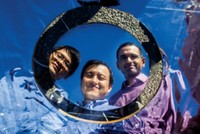Advertisement
Grab your lab coat. Let's get started
Welcome!
Welcome!
Create an account below to get 6 C&EN articles per month, receive newsletters and more - all free.
It seems this is your first time logging in online. Please enter the following information to continue.
As an ACS member you automatically get access to this site. All we need is few more details to create your reading experience.
Not you? Sign in with a different account.
Not you? Sign in with a different account.
ERROR 1
ERROR 1
ERROR 2
ERROR 2
ERROR 2
ERROR 2
ERROR 2
Password and Confirm password must match.
If you have an ACS member number, please enter it here so we can link this account to your membership. (optional)
ERROR 2
ACS values your privacy. By submitting your information, you are gaining access to C&EN and subscribing to our weekly newsletter. We use the information you provide to make your reading experience better, and we will never sell your data to third party members.
Physical Chemistry
Newscripts
An Old Experiment, Even Older Curiosities
by Bethany Halford
August 19, 2013
| A version of this story appeared in
Volume 91, Issue 33

Last month, the Newscripts gang brought you a tale of slow science: the famous pitch drop experiment that has been going on at Australia’s University of Queensland since 1927 (C&EN, July 29, page 72). The setup, which features a funnel full of pitch left to drip ever so slowly, is described as the longest-running laboratory experiment by the folks at Guinness World Records.
The column prompted Don Borseth, a retired chemist in Williamston, Mich., to send us a note contesting the pitch experiment’s claim on the title. “Is Lord Kelvin’s experiment on the diffusion of a copper sulfate solution still being observed at the University of Glasgow?” he asked. “If so, is it not a longer running experiment than the pitch-flow one?”
Good question. In 1872, Sir William Thomson, eventually known as Lord Kelvin, set up two vertical 17.5-foot glass tubes in a lecture theater designed for the experimental aspects of his classes at Glasgow. Kelvin partly filled one tube with a copper sulfate solution and then carefully topped it off with water. He partly filled the second tube with water and then topped it off with colored alcohol.
The idea was to look at the diffusion of the liquids into one another—to observe fluid flow and mixing over time, says Lee Cronin, a chemistry professor at the Scottish university. Today, the solutions sit in a walled-off compartment of Kelvin’s former lecture theater, and they’re still diffusing. The theater was converted into the university’s senate room in 1968 and was renovated again in 2009, but the experiment has not been disturbed in all that time.
Does Glasgow have a bone to pick with Guinness? Unlike the pitch, there’s no custodian of Kelvin’s diffusion experiment. No one is taking measurements these days, but someone could. Newscripts placed a query to Guinness World Records regarding the claim, but there’s been no reply. Perhaps they’re just being true to the speed of the science.
When delving into long-running experiments, one inevitably comes across two pieces of apparatus that aren’t quite experiments but that certainly qualify as scientific curiosities. The younger of the two is the Beverly Clock, which has run without being manually wound since it was constructed in 1864 by watchmaker, mathematician, and astronomer Arthur Beverly.

The clock is housed in the physics department at the University of Otago, in New Zealand. Variations in temperature and pressure drive the clock’s mechanism, which consists of a diaphragm and some weights.
“The clock hasn’t needed winding, but it doesn’t always maintain the weights in a sufficiently wound state,” Myles Thayer, the clock’s current custodian, tells Newscripts. “I have at times had to reset the clock and the weights manually.” Thayer adds, “I wouldn’t consider the clock an experiment. It was, however, the result of many experiments when originally built.”
The other venerable scientific curiosity is the Oxford Electric Bell, or Clarendon Dry Pile. The bell, which makes its home in the Clarendon Laboratory at Oxford University, has been ringing almost continually since 1840. No one can hear it, thankfully, because it resides under two layers of glass.
The design consists of two brass bells, each beneath a type of battery known as a dry pile. A metal sphere moves between the bells, propelled by electrostatic force. In a 1984 paper on the bell, A. J. Croft, of the Oxford physics department, predicted “the clapper seems more likely to wear out than the electro-chemical energy to be exhausted.”
But that has not yet come to pass. “It’s still there,” Jim Williamson, also of the Oxford physics department, tells Newscripts, “and I guess it will go on ringing forever.”
Bethany Halford wrote this week’s column. Please send comments and suggestions to newscripts@acs.org.




Join the conversation
Contact the reporter
Submit a Letter to the Editor for publication
Engage with us on Twitter